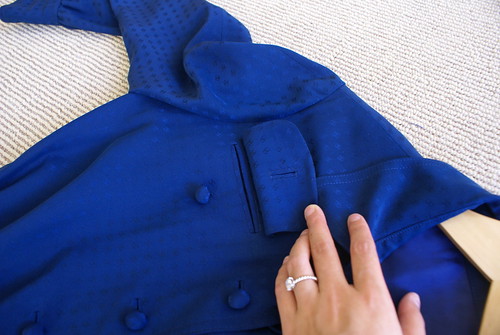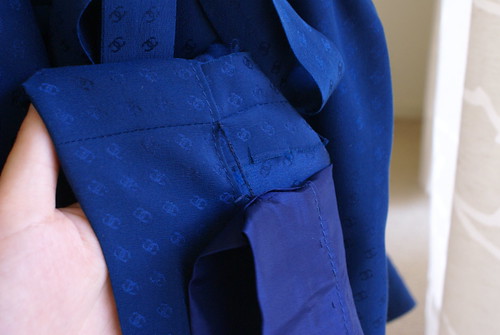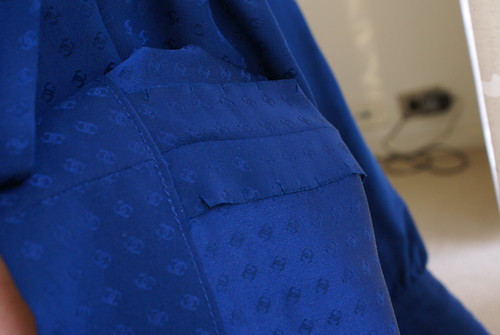
This was one of those dresses that almost didn't make it home with me. I think it was the logo print (never been a big fan of logos) or maybe the cut (I was convinced it was going to be boxy and frumpy and there is no fitting room at this particular thrift store), whatever the reason, I'm sure it was thrift store fate that finally brought me to it. There are no tags of any sort, so I'm pretty sure it's not authentic Chanel. BUT, that being said, whoever made this dress definitely took their time putting it together. I love looking at the construction of older garments because they are so much more detailed than anything you would find on the high street. For example, we have:
bound buttonholes

double welt pocket opening under the flap

extra buttonhole at the collar (eek, so clever!)

bound opening for the waist tie

inside we have,
a chain stitch connecting the lining to the fashion fabric

and the hems are all hand hemmed.
Anyone know why someone would do this? There are clips on all the seams about an inch apart. Is it for alignment purposes? Any ideas?

It fits too!

Just a little (okay, long) tour of a well made garment. Seeing these really helps me verbalize the details that I like in my own sewing. Even a little shirt dress can be made infinitely better by paying attention to the details. Hope you enjoyed!

19 comments:
Oh I love examining those old thrift store garments that someone else made. Someone clearly put a lot of work into this chic blue dress! This was not thrown together in a weekend. I'm sure the seamstress would smile to know that someone else appreciates the details too.
Sometimes they clipped fabric to keep it from fraying. I know it sounds counterintuitive, but it is considered a seam finish. Don't forget that dress also has matching covered buttons! What a great find!
I don't know whether its authentic Chanel or no, but it could well be authentic Chanel fabric. That would explain someone taking such pains with the construction. Beautiful!
The seams are clipped to prevent rippling of the edges.
The buttonhola at the neckline is interesting. Great find!
Fabulous dress! Just wondering...Is there a corresponding button for that top buttonhole? On some vintage dresses buttonholes or slits are used to allow a scarf to be slipped through and thus held in place. I've seen some very fabulous results using this kind of styling. I may have to do something with this kind of detail: hmmmmmm
Such a nice find. It may have been made for someone, by a seamstress, with fabric and pattern brought to them. People used to do that if they didn't have time to sew or know how to. We knew ladies who did that for a part-time income. I would bet that may be authentic fabric, too. Have fun wearing it.
Very nice! It's so detailed, I love it.
*Great* details. The collar button is super-clever!
Mary Beth -- The top buttonhole at the collar stand does have a corresponding button. What a clever idea to allow a hole to slip the scarf through.
Wow, such great details. I can't believe that buttonhole next to the collar. That's really cool.
Such hard work. I love the amazing blue of this dress. And the cute buttons haha :D
What beautiful details.
This is such an interesting garment! No label says "couture” to me, however, it also looks mostly machine made, which it would never be if it was truly couture; it would be almost entirely hand sewn except for perhaps the long seams. Also if it fits you then that tells me it’s based on a commercial sloper; a couture garment looks funny on anyone except the original owner because it was made to fit only that one person and is custom fitted to them in every way. I’m guessing this dress was actually a pre-production sample made for Chanel boutique in maybe the mid-80's, that gorgeous cobalt blue is a very 80’s color. That might also might explain the lack of a label as samples are never labeled. But you know you could tell you? Claire Shaeffer – maybe Mary Beth can help you get in touch with her, I think she would certainly like to see this and she’s an expert on Chanel.
Phyllis-- Thanks for the suggestion. I think I will try to get in contact with her. I'll keep you updated if anything does get figured out.
Thank you so much for sharing this beautiful dress!
God, to be able to sew like that would be a dream come true...and it's so true that older garments are infinitely better made. I just got a bunch of my grandmother's old dresses that she made for herself in the 40s, and the attention to detail is fantastic! The bottons are all covered, the seams are bound, everything is immaculate! Yay for quality!
styleporn.blogspot.com
So many sophisticated details for an otherwise simple dress ! This is definitely what can differentiate couture garments. It would be interesting to compare with a recent chanel garment to see the differences in construction. Thanks for sharing these nice images.
If the seams that are clipped are on selvage edges, they are clipped so that the selvages won't pull tighter than the surrounding fabric. This is always done in drapery panels & works for garments, too.
Carol in Denver
What a detailed dress! I can't imagine anyone today making themselves a dress like that.
Plus, a lot of sewing patterns are "dumbed" down with their sewing construction.
The chain stitch that you mention is also called a "swing tack"...that's what my instructors call it. They're fun to make, we do it by hand.
Post a Comment